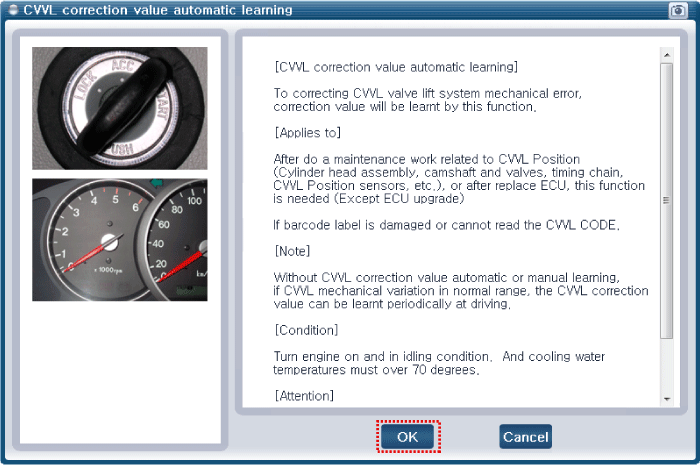Remove the engine cover (A).
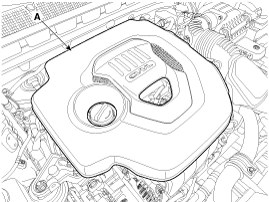
To avoid damage, remove the engine cover on room temperature.
To avoid damage of the engine cover, do not disengage both front and rear mounting point at the same time.
Use fender covers to avoid damaging painted surfaces.
To avoid damage, unplug the wiring connectors carefully while holding the connector portion.
Mark all wiring and hoses to avoid misconnection.
To release the fuel system pressure before removing the engine assembly, start the engine with the fuel pump relay removed. And then turn off the ignition switch after engine stops.
Remove the engine cover (A).

To avoid damage, remove the engine cover on room temperature.
To avoid damage of the engine cover, do not disengage both front and rear mounting point at the same time.
Remove the air duct (A).
Tightening torque :
7.8 ~ 9.8N.m (0.8 ~ 1.0kgf.m, 5.8 ~ 7.2lb-ft)
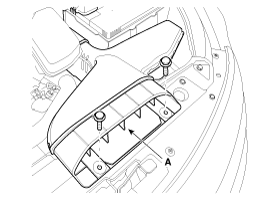
Disconnect the battery terminals (A). The negative terminal first.
Tightening torque
(+) terminal:
7.8 ~ 9.8 N.m (0.8 ~ 1.0 kgf.m, 5.8 ~ 7.2 lb-ft)
(-) terminal:
4.0 ~ 6.0 N.m (0.4 ~ 0.6 kgf.m, 3.0 ~ 4.4 lb-ft)
Remove the battery (A) after removing the mounting bracket (B).
Tightening torque :
8.8 ~ 13.7N.m (0.9 ~ 1.4kgf.m, 6.5 ~ 10.1lb-ft)

Remove the air cleaner assembly.
Disconnect the AFS (Air Flow Sensor) connector (A).
Disconnect the breather hose ( B).
Disconnect the air intake hose (C) and then remove the air cleaner assembly (D).
Tightening torque
Hose clamp bolt:
2.9 ~ 4.9 N.m (0.3 ~ 0.5 kgf.m, 2.2 ~ 3.6 lb-ft)
Air cleaner assembly bolts:
7.8 ~ 9.8 N.m (0.8 ~ 1.0 kgf.m, 5.8 ~ 7.2 lb-ft)
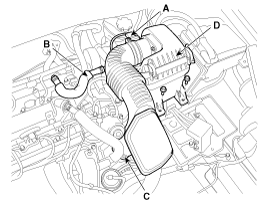
Install the air intake hose while the center of the mark of hose must be in line with the throttle body rib.

Disconnect the front connector (A) wiring clip and then remove the battery tray (B).
Tightening torque:
8.8 ~ 13.7N.m (0.9 ~ 1.4kgf.m, 6.5 ~ 10.1lb-ft)
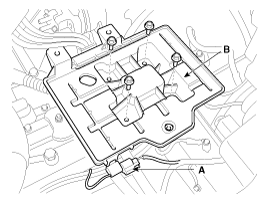
Remove the under covers (A, B).
Tightening torque:
7.8 ~ 11.8N.m (0.8 ~ 1.2kgf.m, 5.8 ~ 8.7lb-ft)
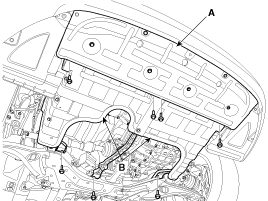
When removing the under cover (B), unfasten the mounting bracket bolts and then remove the under cover and mounting bracket assembly.
Disconnect the power steering fluid return hose (A) for drain the fluid. (HPS only) (Refer to ST group)

Loosen the drain plug, and drain the engine coolant. Remove the radiator cap to help drain the coolant faster. (Refer to Cooling system in this group)
Disconnect the radiator upper hose (A).
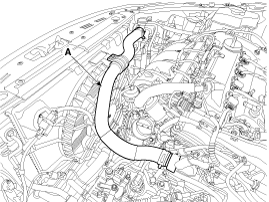
Disconnect the radiator lower hose (A).
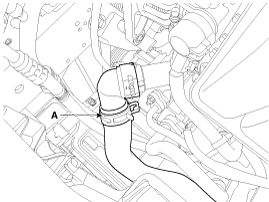
Recover the refrigerant and then remove the high pressure pipe and the low pressure pipe (A). (Refer to Air conditioning system in HA Group.)
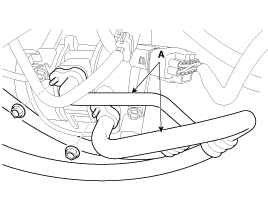
Disconnect the (+) cable (A) from the fuse/relay box and the front connector (B). Then remove the wiring protector (C).

Disconnect the ECM connector (A) from the ECM, the fuse box connector (B) from the fuse/relay box and the engine ground line (C). Then remove the wiring protector (D).

Remove the transaxle wire harness connectors, control cable and hoses from the transaxle. (Refer to AT or MT group).
Disconnect the ATF cooler hose (A). (Refer to AT group)
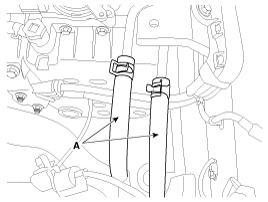
Disconnect the brake booster vacuum hoses (A).

Disconnect the heater hoses (A).
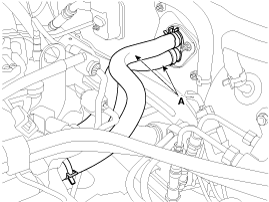
Disconnect the fuel hose (A) and the PCSV (Purge control solenoid valve) hose (B).

Disconnect the pressure hose (A). (HPS only) (Refe to ST group)

Disconnect the power steering oil pressure switch connector (A) and the bracket (B). (HPS only) (Refe to ST group)
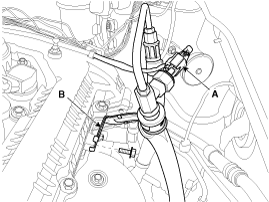
Disconnect the suction hose (A). (HPS only) (Refe to ST group)
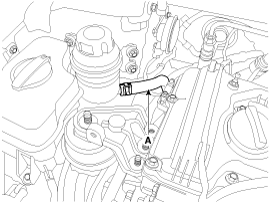
Disconnect the front oxygen sensor connector (A) and then remove it from the bracket.
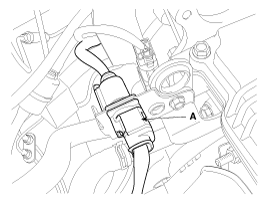
Remove the front muffler ( A).
Tightening torque:
39.2 ~ 58.8 N.m (4.0 ~ 6.0 kgf.m, 28.9 ~ 43.4 lb-ft)
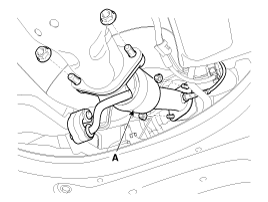
Remove the steering u-joint mounting bolt (A). (Refer to ST group – “Steering gear box”)
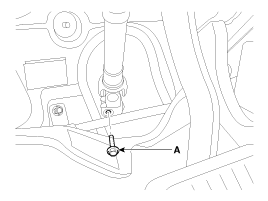
Remove the front wheels. (Refer to SS group)
Remove the lower arms (A). (Refer to SS group – “Front lower arm”)
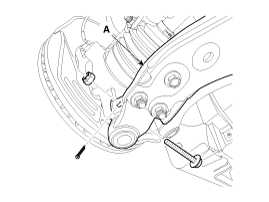
Remove the stabilizer bar links (A). (Refer to SS group – “Front stabilizer bar”)
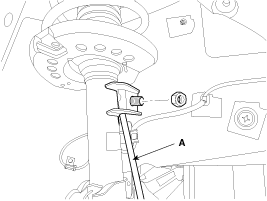
Remove the tie rod ends (A). (Refer to ST group – “Steering gear box”)

Disconnect the drive shafts from the axle hubs. (Refer to DS group – “Front driveshaft”)
Remove the roll rod bracket (A).
Tightening torque
Bolt (B):
107.9 ~ 127.5 N.m (11.0 ~ 13.0 kgf.m, 79.6 ~ 94.0 lb-ft)
Bolts (C):
49.0 ~ 63.7 N.m (5.0 ~ 6.5 kgf.m, 36.2 ~ 47.0 lb-ft)
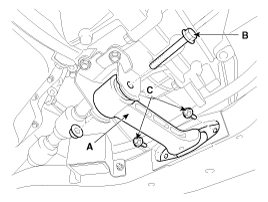
Remove the roll rod mounting support bracket (A).
Tightening torque:
49.0 ~ 68.6 N.m (5.0 ~ 7.0 kgf.m, 36.2 ~ 50.6 lb-ft)

Support the sub frame (A) with a floor jack, and then remove the sub frame mounting bolts and nuts.
Tightening torque
Sub frame mounting bolts & nuts:
156.9 ~ 176.5 N.m (16.0 ~ 18.0 kgf.m, 115.7 ~ 130.2 lb-ft)
Sub frame stay mounting bolts :
44.1 ~ 58.8 N.m (4.5 ~ 6.0 kgf.m, 32.5 ~ 43.4 lb-ft)
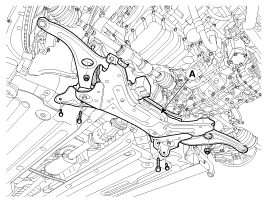
After removing the sub frame mounting bolts and nuts, the engine and transaxle assembly may fall down, so support them securely with floor jack.
Verify that the hoses and connectors are disconnected before removing the engine and transaxle assembly.
Disconnect the ground line (A), and then remove the engine mounting support bracket (B).
Tightening torque
Nut (C):
88.3 ~ 107.9 N.m (9.0 ~ 11.0 kgf.m, 65.1 ~ 79.6 lb-ft)
Bolt (D) and nuts (E):
88.3 ~ 107.9 N.m (9.0 ~ 11.0 kgf.m, 65.1 ~ 79.6 lb-ft)

Disconnect the ground line (A).
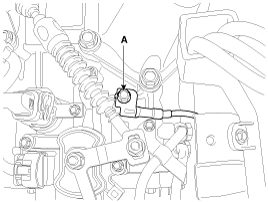
Disconnect the cover (A) and then remove the transaxle support bracket mounting bolts (B).
Tightening torque :
107.9 ~ 127.5 N.m (11.0 ~ 13.0 kgf.m, 79.6 ~ 94.0 lb-ft)
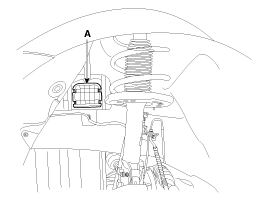

Lower the engine and transaxle assembly using a floor jack and then remove the engine and transaxle assembly by lifting vehicle.
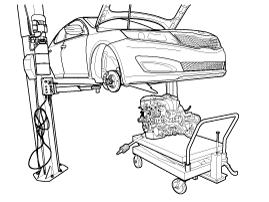
When remove the engine and transaxle assembly, be careful not to damage any surrounding parts or body components.
Installation is in the reverse order of removal.
Perform the following:
Adjust a shift cable.
Refill engine with engine oil.
Refill a transaxle with fluid.
Refill a radiator and a reservoir tank with engine coolant.
Clean battery posts and cable terminals and assemble.
Inspect for fuel leakage.
After assembling the fuel line, turn on the ignition switch (do not operate the starter) so that the fuel pump runs for approximately two seconds and fuel line pressurizes.
Repeat this operation two or three times, then check for fuel leakage at any point in the fuel line.
Bleed air from the cooling system.
Start engine and let it run until it warms up (until the radiator fan operates 3 or 4 times).
Turn off the engine. Check the level in the radiator, add coolant if needed. This will allow trapped air to be removed from the cooling system.
Put radiator cap on tightly, then run the engine again and check for leaks.
After engine assembly replacement, perform the manual learning or automatic learning for CVVL valve lift adaptation values.
After replacing the engine assembly, ECU or any parts related with CVVL system, which can cause the valve lift variation, the manual learning or automatic learning for CVVL valve lift adaptation values should be performed.
In case the mechanical valve lift variation is within the normal range, the self-learning can be performed during driving the vehicle even if the manual learning or automatic learning has not been performed. But the self-learning performs learning at different speed depending on diving conditions.
To compensate for mechanical variations of CVVL valve lift, enter the CVVL CODE 12 digit on the bar code label attached to the engine cylinder head cover to the ECU through a diagnostic equipment.
CVVL CODE is the valve lift variation information of the engine assembly precisely measured in an engine assembly plant. Thus, when replacing the cylinder head assembly, the intake camshaft, intake valve and etc. the CVVL valve lift variation changes so the bar code label attached to the cylinder head cover should be removed. In addition, when replacing the cylinder head cover, remove the existing bar code label from the head cover and attach it to the new head cover.
Manual learning is necessary when;
Engine assembly replacement
ECU replacement
Manual learning is more accurate calibration than automatic learning so the manual learning should be carried out if the CVVL CODE is available. In case the bar code label is removed or damaged then the CVVL CODE is not available, perform the automatic learning.
Connect the GDS to the vehicle.
Turn the ignition switch ON (not running).
Select the “CVVL correction value manual learning” menu in Vehicle S/W Management - ID registration on GDS.
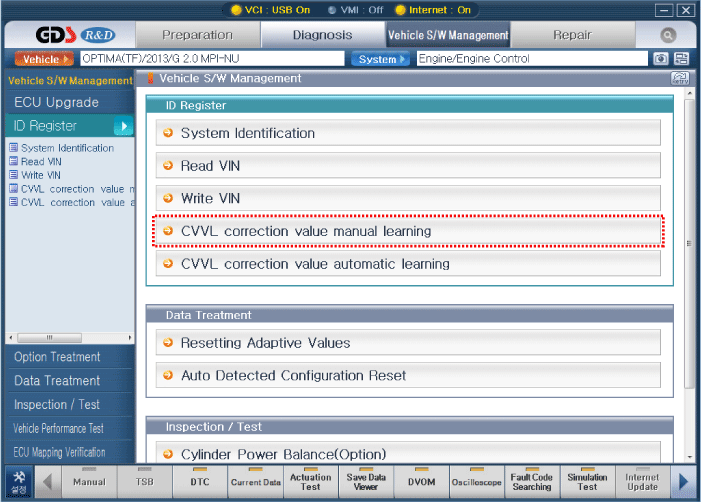
Perform the manual learning for CVVL Valve Lift Adaptation according to the procedure displayed on the GDS.
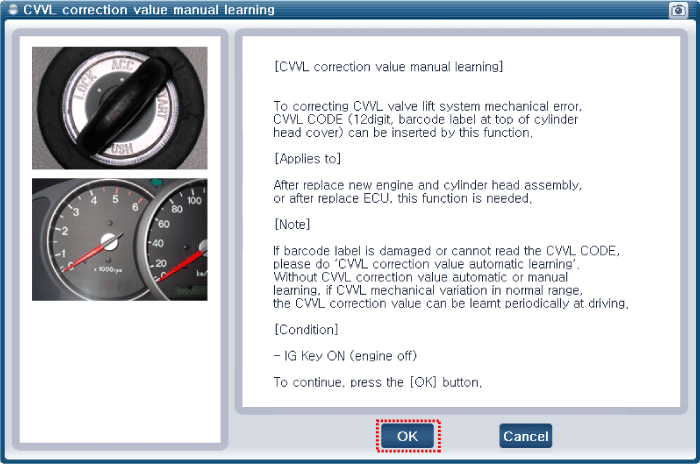
Automatic learning using a diagnostic equipment compensates for mechanical variations of CVVL valve lift.
Automatic learning is necessary when;
Cylinder head assembly, intake camshaft or intake valve replacement
The bar code label is removed or damaged then the CVVL CODE is not available
Connect the GDS to the vehicle.
Start the engine.
Select the “CVVL correction value automatic learning” menu in Vehicle S/W Management - ID registration on GDS.

Perform the automatic learning for CVVL Valve Lift Adaptation according to the procedure displayed on the GDS.
